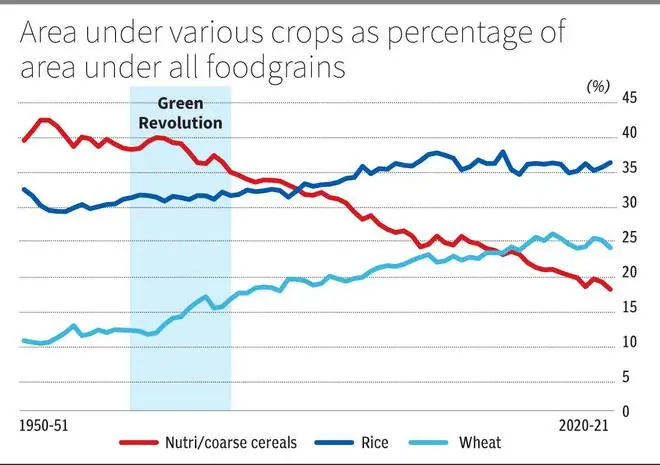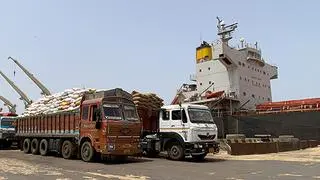When it comes to food and nutrition, governments around the world have, for long, focused on food security at the expense of nutritional security. The third agricultural revolution played an important role in promoting the use of certain grains over the others as one of the policies to mitigate hunger. The advent of the Green Revolution post World War II led to increased production of wheat and rice all over the world.
However, an unintended consequence of this was the decline in the area of nutrition-rich crops like maize, jowar, bajra and ragi.
Traditionally, India’s consumption basket was well-balanced with evidence of consumption of nutrient-rich millets dating back to 3000 BC. However, post Green Revolution, the trend got reversed, while millet yield in India tripled from 414 (kg/ha) in 1961 to 1,352 (kg/ha) in 2021, the percentage of area under millets halved from more than 30 million ha to 13.6 million ha in the same time period.

A similar trend was observed at the global level, where the average yield increased from 592 (kg/ha) to 972 (kg/ha) while the total area under harvesting saw a considerable decline from 43.4 million ha to 30.9 million ha in the same time period.
Changing pattern
The per capita consumption of millets declined by 38.6 per cent between 1972-73 and 1987-88 in rural areas, and that of rice and wheat increased by 6.8 per cent and 27.3 per cent during the same period. Between 2004-05 and 2011-12, the ratio further declined to 45 per cent and that of wheat increased to 3.4 per cent.
The decline in millet consumption across the country was perpetuated by the shift in production towards fine cereals like rice and wheat due to availability of sophisticated production technologies and backed by supporting policies such as assured irrigation facilities, minimum support prices, etc.
Bringing back millets in the consumption basket requires both supply side endeavour and behavioural push. With India leading the G20 presidency, the issue of food security will get a renewed impetus.
As the repercussions of food insecurity could be felt in terms of rising malnutrition and declining productivity of the global workforce, the Indian presidency’s agenda of promoting millets through the G20 Millet International Initiative for Research and Awareness (MIIRA) can reinvigorate the balance between nutrition security and food security.
Strengthening Agricultural Marketing Intelligence Systems (AMIS) is one of the important focus areas under the theme on Enhancing Food Security and Nutrition, which will be discussed under G20’s Agriculture Working Group.
This can promote timely information sharing on critical inputs for agriculture. The lead taken by the Indonesian presidency in 2022 by organising a Joint G20 Finance and Agriculture Ministers (JFAM) meeting to garner political support on food insecurity and malnutrition problems is an important step.
India is one of the leading producers and exporter of millets in the world, with an estimated share of around 41 per cent in global production. India’s export of millets has gone up from $59.75 million in 2020-21 to $64.28 million in 2021-22.
The market for millets is estimated to grow from its current value of more than $9 billion to over $12 billion by 2025. Looking at the expected growth in demand for millets and its potential to balance the need for nutritional and food security, the Centre is taking multiple initiatives for both awareness and adoption.
To celebrate the International Year of Millets, the Agricultural and Processed Food Products Export Development Authority (APEDA) under the Ministry of Commerce has prepared a detailed year-long strategy. The Centre has also planned to facilitate the participation of exporters, farmers, and traders in 16 international trade expos and Buyer Seller Meets (BSMs) such as Gulfood 2023, Foodex, etc.
It is time that crops are cultivated to address the needs of the emerging society. With the change in consumerism patterns and increased adoption of ready-to-eat food, we need to make sure that the nutritional value is in sync with the commodity in the supply chain.
Higher shelf life and balanced protein, fat, and fibre content, make millet the best contender for addressing the consumer needs of the rising middle class. This will be facilitated by the export promotion of value-added products in Ready to Eat (RTE) and Ready to Serve (RTS) categories by domestic start-ups and international retail supermarket chains.
Research push
To carry out strategic research on millets, the government formed the Indian Institute of Millet Research (IIMR) in 1958.
However, it was upgraded only in 2015 with the mandate to transform subsistence farming of millets into a globally competitive climate-resilient nutri-cereal enterprise. Over the years, IIMR has been successfully conducting training modules, business plan development, supply chain management, etc., for start-ups to scale their business.
Further, to make India a global hub for “Shree Anna”, the Budget has proposed to support IIMR as a Centre of Excellence for sharing best practices, research, and technologies at the international level.
The puzzle of malnutrition, lifestyle diseases and natural resource degradation can be solved only with a multi-pronged approach. Millets being a healthy and climate-friendly solution are certainly a part of it.
Kumar is Director in the office of Chief Economic Adviser, Department of Economic Affairs, and Banka is Assistant Director in the office of CEA








Comments
Comments have to be in English, and in full sentences. They cannot be abusive or personal. Please abide by our community guidelines for posting your comments.
We have migrated to a new commenting platform. If you are already a registered user of TheHindu Businessline and logged in, you may continue to engage with our articles. If you do not have an account please register and login to post comments. Users can access their older comments by logging into their accounts on Vuukle.